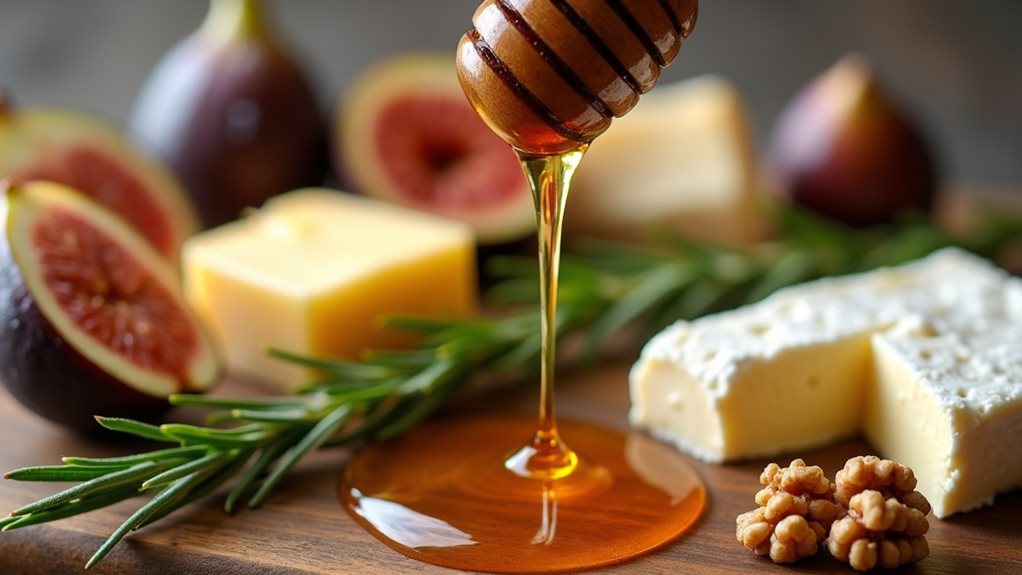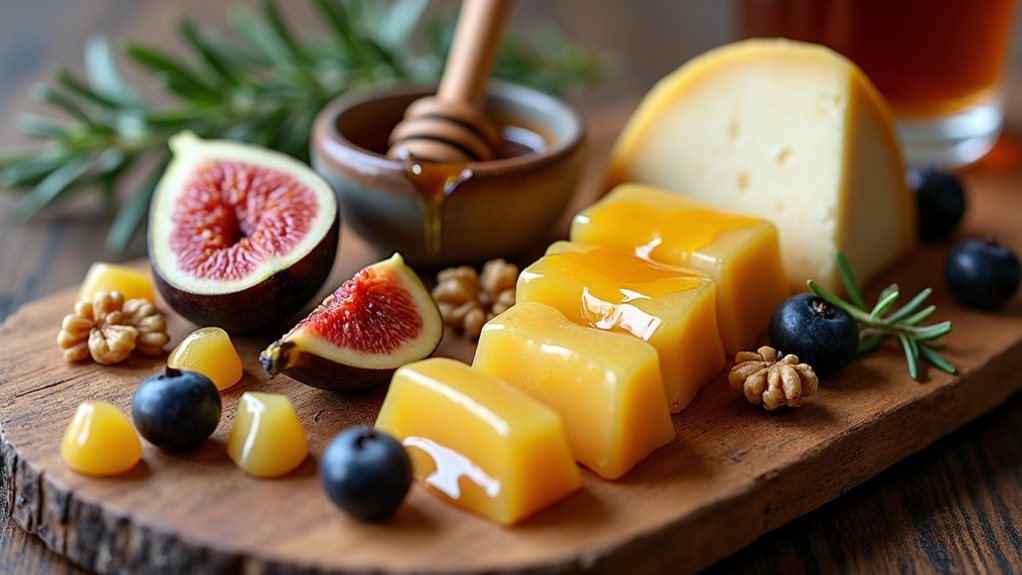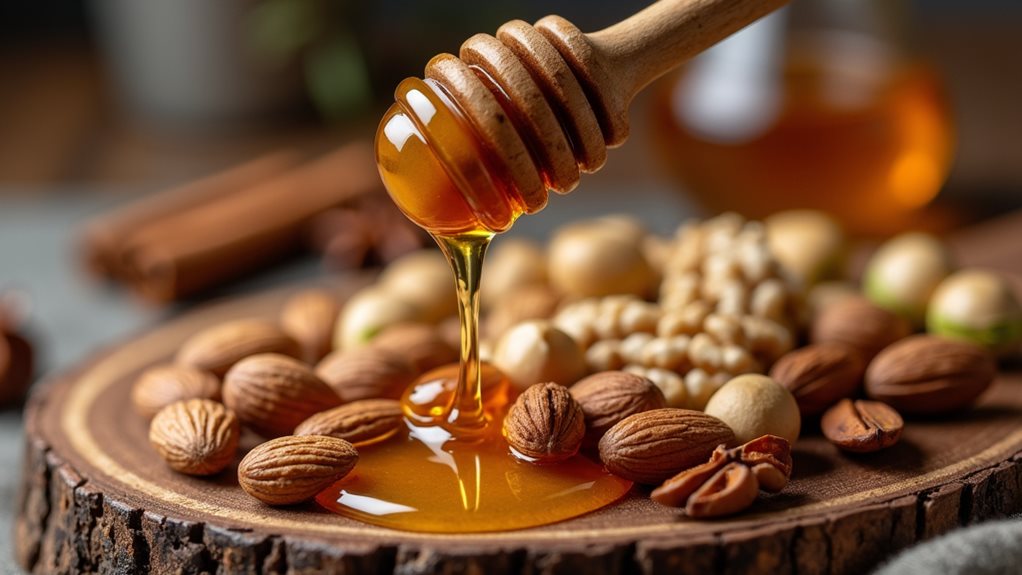Honey pairs beautifully with a variety of ingredients due to its complex flavor profile. You'll find it enhances cheeses (try blue cheese with buckwheat honey), fruits (orange blossom honey with citrus), nuts (almonds for sweetness, walnuts for earthiness), and herbs (rosemary, lavender, thyme). It also creates exciting tension when combined with spicy elements like habanero. For seasonal enjoyment, try lavender honey with goat cheese in spring or buckwheat honey with roasted vegetables in autumn. Discover how honey's 200+ compounds can transform your culinary creations.
The Sweet Science: Why Honey Pairs Well With Other Foods

When you understand the chemistry behind honey's remarkable versatility, you'll discover why it enhances nearly everything it touches. Honey's complex flavor profiles allow it to function as a bridge between contrasting tastes, seamlessly balancing sweetness with savory, tangy, or spicy elements.
The secret lies in honey's composition—containing over 200 compounds that interact differently with various ingredients. Honey reflects distinct terroir characteristics that vary widely based on the nectar sources used by bees.
Honey's magic isn't simply sweetness, but a symphony of hundreds of compounds creating unique reactions with every ingredient it meets.
When you're combining honey with nuts, its sticky sweetness amplifies their natural oils and earthy qualities. With cheeses, it cuts through richness while enhancing creaminess.
Balancing sweetness isn't just about adding sugar; it's about creating harmony. You'll find honey excels at this balancing act, whether you're glazing meats, crafting vinaigrettes, or elevating desserts with its caramelized notes.
Adventurous culinary enthusiasts can explore the increasingly popular hot honey trend that pairs honey with jalapeño or chipotle for an exciting contrast that stimulates the palate with both sweet and spicy notes.
A Complete Guide to Honey and Fruit Combinations
The marriage of honey and fruit creates one of nature's most perfect culinary unions, offering countless possibilities for both traditional and innovative flavor combinations.
You'll discover that different honey types complement specific fruit varieties in surprisingly harmonious ways. Try pairing orange blossom honey with citrus fruits to enhance their natural brightness, or experiment with robust buckwheat honey alongside papaya for a complex flavor profile.
Stone fruits like peaches and plums shine when drizzled with warm, floral honeys, while tropical varieties such as mango and pineapple benefit from eucalyptus or light wildflower honey. Creating a sophisticated appetizer with figs and cheese alongside honey offers an elegant solution for entertaining guests.
Don't overlook classic pairings like apples with wildflower honey or figs with bold, barrel-aged varieties. For a delicious and nutritious breakfast option, consider swirling vanilla bean honey into a bowl of Greek yogurt topped with fresh berries and granola. The key is balancing acidity and sweetness—let the natural characteristics of both ingredients enhance each other.
Creating Perfect Honey and Cheese Boards

When crafting your honey and cheese board, you'll want to master specific flavor matchups, such as pairing tangy blue cheese with bold buckwheat honey or creamy brie with delicate orange blossom varieties.
Arrange your board strategically by placing honey in small vessels near compatible cheeses, creating visual flow with complementary crackers, nuts, and fruits positioned between cheese varieties.
Consider seasonal influences in your selections, opting for lighter honeys and fresh goat cheeses in spring and summer, while shifting to robust aged cheeses with darker honeys during fall and winter months.
For an elegant presentation that balances sweet and savory elements, serve brie on water crackers with a honey drizzle and pistachios for a delightful appetizer option.
Enhance your tasting experience by including a variety of textures, combining crunchy nuts with soft cheeses and sticky honey to create a more satisfying sensory contrast.
For a truly elevated presentation, create decorative edges on any pie-based cheese boards using the fluting technique to provide an artisanal touch that complements the honey and cheese pairings.
Honey-Cheese Flavor Matchups
Creating perfect honey and cheese pairings involves understanding the delicate dance between contrasting and complementary flavors. The honey texture dramatically affects how it interacts with different cheese varieties—lighter, floral honeys embrace creamy cheeses like brie, while robust options like buckwheat honey stand up to stronger flavors.
For blue cheese, try blueberry honey to mellow its intensity and create a smoother taste experience. Serving blue cheese with halved walnuts adds a delightful textural contrast to the pairing. Pair tangy goat cheese with sweet clover honey to balance its sharpness. The salty notes in Parmigiano-Reggiano find their perfect counterpoint in a light drizzle of orange blossom honey.
When working with smooth ricotta, enhance its subtle character with lavender honey and fresh figs. Remember that regional pairings offer authentic combinations—European cheeses shine with their traditional local honey counterparts. Consider serving your cheese board with toasted baguette slices to provide a neutral base that enhances both the cheese and honey flavors.
Strategic Board Arrangement
Mastering the art of honey and cheese board arrangement begins with strategic placement rather than random scattering of ingredients.
You'll want to establish visual harmony through calculated item spacing, positioning larger cheese wedges and honey bowls first to anchor your composition.
For ideal board aesthetics, distribute small dishes of spreads and pickled elements across the surface, maintaining balance while creating inviting pathways between components.
Include at least three cheese varieties with contrasting textures, and position crackers and breads strategically for easy access. Enhance your board with specialty options like Pink Pepper Blossom Honey which pairs beautifully with stronger cheeses like Stilton and Pecorino.
Create dimension by introducing height variation—perhaps elevating certain elements on small pedestals.
Incorporate color through fresh fruits, herbs, and different honey varieties.
Remember that pairing regional cheese with honey from the same area can create an authentic tasting experience since local environments influence the flavors of both products.
Remember to take into account lighting conditions, as proper illumination will showcase the textures and colors of your carefully crafted board.
Seasonal Pairing Tips
Beyond the visual arrangement of your cheese board, the seasons offer natural guidance for creating memorable flavor combinations. Let your selections reflect nature's current offerings for the most harmonious pairings.
In spring pairings, showcase the delicate marriage of lavender honey with fresh goat cheese, capturing the season's gentle awakening.
When summer arrives, shift to clove honey with grilled meats or brighten salads with orange blossom varieties.
As temperatures cool, embrace autumn flavors by drizzling buckwheat honey over roasted root vegetables or warming your morning oatmeal with cinnamon-infused honey.
Winter calls for eucalyptus honey in steaming beverages and sage honey alongside sharp cheeses.
For year-round appeal, honeycomb creates a stunning visual centerpiece that adapts to any seasonal cheese selection you've curated.
Honey and Nuts: Classic Combinations for Snacking and Baking

When honey meets nuts, a magical flavor transformation occurs that has delighted palates across cultures for centuries. The contrast between smooth, sweet honey and crunchy, earthy nut varieties creates a sensory experience that's both satisfying and complex.
Almonds offer a rich nuttiness that enhances honey's natural sweetness, while walnuts bring an earthy depth that creates compelling flavor contrasts.
For your next culinary adventure, try coating pecans with honey and a touch of cinnamon—their buttery quality harmonizes perfectly with honey's amber sweetness.
Pistachios, with their slightly sweet profile, create a balanced pairing that shines in Mediterranean-inspired dishes.
Beyond delicious taste, you'll benefit from the energy boost of natural sugars and the nutritional punch of antioxidants and minerals.
Elevating Dishes With Honey and Herbs
Herbs can transform your honey experiences beyond simple sweetness, creating complex flavor profiles that enhance both sweet and savory dishes.
You'll find that aromatic herbs like rosemary, lavender, and thyme each bring unique characteristics that complement honey's natural sweetness, while allowing you to explore culinary applications from desserts to marinades.
These natural flavor enhancers work by infusing their essential oils into honey, creating versatile ingredients that can elevate everything from morning tea to elaborate dinner preparations.
Natural Flavor Enhancers
The marriage of honey with carefully selected herbs creates flavor profiles that transcend ordinary sweetness, offering both culinary excitement and wellness benefits.
When you explore herbal infusions like lavender or rosemary in honey, you're not just enhancing flavor—you're revealing therapeutic properties that support everything from cognitive function to restful sleep.
For maximum impact, try infusing honey with cinnamon or ginger to add warmth and complexity to both sweet and savory dishes.
These spice-honey combinations work brilliantly as glazes for roasted vegetables or as finishing touches for breakfast items.
You'll find that fruit pairings, particularly berries, complement honey's natural sweetness while creating balanced flavor profiles.
The honey acts as a natural solvent, extracting and preserving the medicinal properties of these enhancers while transforming ordinary ingredients into extraordinary culinary experiences.
Similar to maple syrup, honey creates a beautiful caramelized finish when added during the final minutes of roasting vegetables, enhancing both their appearance and flavor.
Beyond Sweet Infusions
Venturing beyond traditional sweetness, infused honeys open up a world of culinary possibilities that transform ordinary meals into memorable dining experiences.
Herb honey, like rosemary or thyme infusions, can elevate meat glazes with complex flavor profiles that balance sweetness with savory notes. For those seeking bolder tastes, spicy honey infused with chili flakes or garlic creates dynamic contrasts that enhance everything from cheese boards to stir-fries.
Try these innovative applications to expand your honey repertoire:
- Drizzle lavender-infused honey over goat cheese for an aromatic appetizer that will intrigue your guests.
- Brush sage honey onto roasted vegetables during the final minutes of cooking for caramelized depth.
- Whisk mint honey into vinaigrettes for salads that balance invigorating herbs with natural sweetness.
The culinary versatility of honey extends to Mediterranean dishes where it can be paired with spring onions and feta to create a sweet-savory balance reminiscent of traditional regional cooking.
Spicy and Sweet: Honey and Spice Pairings to Try
Discovering the exquisite interplay between spicy and sweet flavors can transform your culinary adventures with honey. The dynamic profiles of spicy honey offer a perfect flavor balance, where natural sweetness provides contrast to various heat levels.
You'll find unique infusions like habanero or ghost pepper honey create an exciting tension that elevates both elements. For adventurous pairings, try drizzling cinnamon-infused honey over roasted vegetables or incorporating ginger honey into Asian-inspired marinades.
Cardamom honey brings Middle Eastern flair to desserts, while cayenne honey creates a surprising kick on pizza topped with prosciutto. You can customize these culinary uses to your preferred intensity, from the gentle warmth of clove to the fierce heat of ghost peppers balanced with citrus.
Savory Applications: Unexpected Ways to Use Honey in Main Dishes
While spicy and honey creations tantalize the taste buds, honey's true versatility extends far beyond sweet applications into the domain of savory cooking.
You'll find savory honey applications transform ordinary dishes into extraordinary culinary experiences. Drizzle honey over grilled steaks, incorporate it into fish glazes with soy sauce, or add it to roasted vegetables with rosemary for depth and complexity.
Try these unexpected uses of honey in your next meal:
- Create a honey-balsamic reduction for roasted Brussels sprouts that will convert even the staunchest vegetable skeptics.
- Brush honey-garlic glaze on salmon during the final minutes of cooking for a caramelized, flavorful crust.
- Stir a teaspoon of honey into tomato-based pasta sauces to balance acidity and add subtle depth.
Seasonal Honey Pairing Ideas for Year-Round Enjoyment
As honey's complex flavor profiles evolve throughout the seasons, you'll discover each variety offers unique pairing opportunities that complement nature's shifting bounty.
Spring invites you to experiment with lavender honey and goat cheese, while summer calls for orange blossom honey in invigorating salads, delivering subtle health benefits with each bite.
When autumn arrives, shift to buckwheat honey with roasted vegetables, or enhance your morning oatmeal with warming cinnamon honey.
Winter's chill pairs perfectly with eucalyptus honey in hot beverages, soothing sore throats while providing comfort.
For versatility across all seasons, combine different honey varieties with berries, cheeses, or nuts—each pairing not only elevates your culinary creations but also maximizes the natural health benefits these golden elixirs provide throughout the year.
Frequently Asked Questions
Does Honey Crystallization Affect Its Pairing Potential?
Yes, crystallized honey actually enhances your pairing potential. It concentrates the flavor profile, offers a spreadable texture, and maintains all nutritional benefits. You'll find it's more versatile in recipes than liquid honey.
Can Different Honey Varietals Be Substituted in Pairing Recipes?
You can substitute, you can explore, you can innovate with honey varietals based on flavor intensity and floral notes. Your pairing versatility expands when you understand each honey's unique profile and complementary characteristics.
How Does Honey's Terroir Impact Food Pairing Choices?
Terroir influence shapes your pairing choices fundamentally. You'll find regional flavors in honey reflect the land's essence, guiding you to create innovative combinations that honor geographic connections between honey and complementary foods you're enjoying.
Are Raw and Processed Honeys Interchangeable in Sophisticated Pairings?
Despite appearances, they're not! You'll discover raw honey benefits—complex flavors and antioxidants—elevate sophisticated pairings, while processed honey characteristics offer consistency but lack the nuanced depth that adventurous culinary innovators often seek.
What Temperature Maximizes Honey's Flavor When Pairing With Foods?
You'll maximize honey's flavor enhancement at warm (not hot) temperatures below 40°C (104°F). This gentle warming releases complex notes without destroying beneficial properties, allowing better integration with your innovative culinary creations.
Final Thoughts
You've now entered the golden gates of honey pairing possibilities. Whether drizzled over summer fruits, married with robust cheeses, or dancing with warming spices, nature's liquid gold transforms ordinary ingredients into extraordinary experiences. Remember to contemplate honey varieties—each offering their unique personality—when creating your culinary masterpieces. The next time you're looking to enhance a dish, reach for that amber elixir and let its complex sweetness work its magic.













